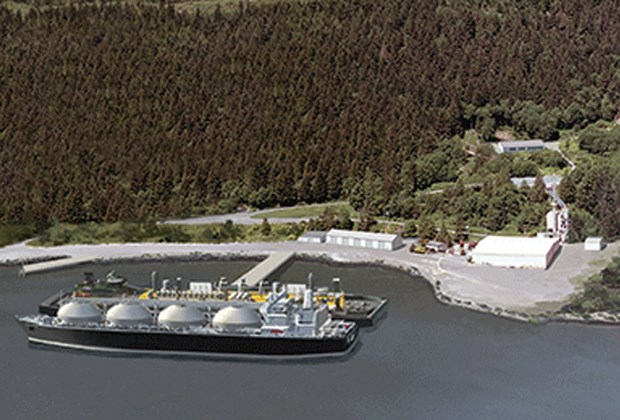At least a few North Shore residents are voicing environmental concerns about a Liquefied Natural Gas facility proposed for the site of a former pulp mill near Squamish.
Woodfibre Natural Gas Limited - part of the Pacific Oil and Gas group of companies owned by an Indonesian tycoon - is seeking to liquefy, load and export 2.1 million tonnes of LNG per year, beginning as early as 2017.
Under the proposal, natural gas would be sent to the facility to be liquefied through existing gas pipelines to Squamish.
Once operational, the $1.7 billion facility would ship the LNG in approximately 40 doublehulled, Asia-bound vessels each year. Woodfibre's parent company, Pacific Oil and Gas, owns an LNG import facility in China.
Not everyone is thrilled with the plan.
Some residents worry the facility could turn the tide for Howe Sound, which they say has only recently seen the return of wildlife driven out by previous decades of industrial development.
Laurie Parkinson of North Vancouver attended a Feb. 4 information meeting at Gleaneagles Golf Course where she was troubled to learn that part of the liquefaction process may take place on a barge.
"This would create a lot of sound that would carry into the water and scare away the marine mammals that have only recently returned," she said. "Howe Sound is just so beautiful and I want it to stay unindustrialized."
Woodfibre Natural Gas is working with environmental consultants to find out how much noise currently exists, according to Byng Giraud, Woodfibre's vice-president of corporate affairs.
Woodfibre would likely do some of their work on a barge and some on land, he said.
The company is still months away from beginning the environmental assessment process, said Giraud.
But many questions brought up at the Gleneagles meeting - including queries about how the gas would be compressed - were not satisfactorily answered, according to Parkinson.
"A lot of them they hedged on quite a bit," she said. "To be fair to them this is an extremely preliminary meeting."
The company has not yet decided which liquefaction method it will use, said Giraud.
"Our preference is to go electric, we think the community's preference is to go electric, but we also have to do a system impact study with B.C. Hydro to find out actually if that's possible," he said.
The gas company entered into a deal with Western Forest Products last year to buy the site of the former Woodfibre pulp mill, an 89-hectare water-access site on Howe Sound about seven kilometres from downtown
Squamish. The sale of the site to the gas company will not be finalized until ongoing environmental remediation is complete, according Giraud.
"It was 100 years of debris offshore, woodchips and logs that basically denuded the foreshore of fish life," he said.
Many impacts to the "highly disturbed" industrial site took place over the last century, he said.
"Maybe we can do things that would have less impact than the pulp mill," he said. "This type of operation doesn't really impact the foreshore."
Given its deepwater port and existing gas pipeline, the site is ideal for an LNG plant, according to Giraud.
The company is working with Fortis to twin a 52-kilometre pipeline, which would loop from the top of the Coquitlam watershed to the Squamish site.
"After this current expansion, that's the limit of the line. So we've applied to export all the gas Fortis is able to provide to us. There's no more available," Giraud said.
The sheer volume of proposals earmarked for Howe Sound is disquieting, according to author and diver Bernard Hanby.
"We have something precious there and we're going to destroy it," he said.
"We're selling this province to industrial interests."
Construction of the LNG plant would require 600 workers. Once operational, the plant would have a staff of 100 full-time workers.
"There's a really good chance we could lean heavily on local labour, both in construction and in operations, that being said, a small amount of the jobs are highly specialized, highly technical," Giraud said.



